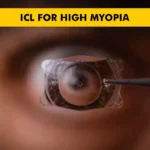What Is a Corneal Ulcer?
A corneal ulcer is an open sore on the cornea, the transparent front layer of the eye. It occurs due to infections, injuries, or underlying eye conditions and, if left untreated, can result in severe vision loss or blindness. The cornea plays a crucial role in focusing light into the eye, and any damage to it can significantly impair vision.
A corneal ulcer can be classified based on the cause, severity, and depth of tissue involvement. By understanding the stages of corneal ulcer, eye specialists can provide timely treatment, improving outcomes and preventing complications.
Stages of Corneal Ulcer
The progression of a corneal ulcer occurs in distinct stages, each requiring different levels of treatment and care. Early intervention is essential to prevent further deterioration of vision and eye health.
Stage 1 – Early Stage (Epithelial Damage)
- Description: The ulcer begins with damage to the corneal epithelium, which is the outermost protective layer of the cornea. This damage could be due to infections (bacterial, viral, fungal, or parasitic), mechanical trauma, or dryness.
- Common Causes:
- Bacterial infections, especially in contact lens wearers
- Viral infections, such as herpes simplex virus
- Dry eye syndrome leading to corneal erosion
- Eye injuries from dust, chemicals, or foreign bodies
- Symptoms:
- Eye redness and irritation
- Pain or a feeling of something in the eye (foreign body sensation)
- Excessive tearing
- Sensitivity to light (photophobia)
- Treatment:
- Antibiotic or antiviral eye drops to prevent infection
- Artificial tears to keep the eye lubricated
- Avoiding further irritation, such as rubbing the eye
Stage 2 – Stromal Infiltration and Ulceration
- Description: If the infection or trauma progresses, it penetrates the corneal stroma, which is responsible for the cornea’s strength and transparency.
- Effects on Vision: As the infection deepens, it causes swelling and opacification of the cornea, leading to blurred vision.
- Symptoms:
- Increased eye pain and discomfort
- Noticeable clouding or white spot on the cornea
- More intense redness and swelling of the eyelids
- Possible discharge from the eye
- Treatment:
- Stronger antibiotic or antifungal eye drops, often administered hourly
- Steroid medications may be considered in some cases to control inflammation (only under specialist supervision)
- Close monitoring by an ophthalmologist
Stage 3 – Advanced Ulceration and Thinning
- Description: At this stage, the ulcer extends deeper into the corneal layers, increasing the risk of corneal perforation. The cornea may become extremely thin, leading to potential rupture.
- Complications:
- Corneal perforation, which can lead to permanent vision loss
- Risk of secondary infections spreading to other parts of the eye (endophthalmitis)
- Increased intraocular pressure, leading to further complications
- Symptoms:
- Severe pain and inability to keep the eye open
- Complete loss of vision clarity
- White or grayish ulcer with discharge
- In extreme cases, fluid leakage from the eye if perforation occurs
- Treatment:
- Intensive treatment with fortified antibiotic or antifungal drops
- Oral medications to control inflammation and infection
- Surgical intervention may be needed, such as amniotic membrane grafting or corneal transplant
Stage 4 – Healing and Scarring
- Description: If treatment is successful, the ulcer starts healing, but scarring may remain, affecting vision.
- How to tell if corneal ulcer is healing?
- Reduction in pain and redness
- Decrease in discharge and light sensitivity
- Improvement in vision clarity, though it may not be fully restored if scarring is present
- Potential Long-Term Effects:
- Mild to severe corneal scarring, depending on ulcer severity
- Need for corrective eyewear or surgical intervention if scarring affects vision significantly
- Post-Treatment Care:
- Continued use of lubricating and antibiotic eye drops
- Avoiding contact lenses until cleared by an ophthalmologist
- Regular follow-ups to monitor corneal health
Also read a brief discussion on Cornea.
Corneal Ulcer Causes
A corneal ulcer can develop from multiple factors, including:
- Infections:
- Bacterial infections – Common in contact lens wearers, especially when lenses are worn overnight.
- Fungal infections – Often occur after eye trauma with organic material like plant matter.
- Viral infections – Herpes simplex virus is a leading cause.
- Parasitic infections – Acanthamoeba infections are rare but severe.
- Trauma and Eye Injuries:
- Chemical burns, foreign bodies, or scratches on the cornea.
- Underlying Eye Conditions:
- Severe dry eye syndrome, vitamin A deficiency, or eyelid disorders leading to improper eye closure.
Types of Corneal Ulcer
- Bacterial Corneal Ulcer – Rapidly progressing; requires aggressive treatment.
- Fungal Corneal Ulcer – Often misdiagnosed; needs antifungal therapy.
- Viral Corneal Ulcer – Recurrent; commonly caused by herpes simplex.
- Parasitic Corneal Ulcer – Rare but highly resistant to treatment.
Corneal Ulcer Treatment and Management
- Antibiotic or antifungal eye drops
- Steroids (if indicated) to control inflammation
- Frequent monitoring and follow-up appointments
- In severe cases, corneal transplantation
Protect Your Vision – Early Treatment Matters! Consult an Eye Specialist!
FAQs
What is the main cause of corneal ulcer?
Corneal ulcers can be caused by various factors, including infections (bacterial, viral, or fungal), trauma to the eye, underlying health conditions, and improper contact lens use.
What is the cure for corneal ulcer?
This is a placeholder tab content. It is important to have the necessary information in the block, but at this stage, it is just a placeholder to help you visualise how the content is displayed. Feel free to edit this with your actual content.
Do corneal ulcers go away?
With proper treatment, most corneal ulcers can heal within a few weeks. However, the healing time may vary depending on the severity of the ulcer and the individual’s response to treatment.
Will corneal ulceration go away?
Corneal ulceration can go away with appropriate treatment and care. However, it is important to seek medical attention for proper diagnosis and treatment, as untreated corneal ulcers can lead to complications and vision loss.
Is a corneal ulcer a medical emergency?
Corneal ulcers require prompt medical attention, but they may be considered a medical emergency. You must visit an eye doctor within a day and avoid self medication.
What are the four stages of a corneal ulcer?
The four stages of a corneal ulcer are epithelial defect, stromal infiltration, Descemetocele, and corneal perforation. Early detection and treatment are crucial to prevent the ulcer from progressing to more severe stages.
What Are the Early Symptoms of a Corneal Ulcer?
Early corneal ulcer symptoms include eye redness, pain, sensitivity to light, and blurred vision. Immediate treatment is necessary to prevent progression.
How Can a Corneal Ulcer Be Prevented?
- Proper contact lens hygiene
- Avoiding eye trauma
- Immediate treatment of eye infections
How Long Does It Take for a Corneal Ulcer to Heal?
Mild ulcers may heal within a few days, while severe cases may take weeks or require surgery.
What Happens if a Corneal Ulcer Is Left Untreated?
It can lead to permanent blindness, corneal perforation, or the need for a transplant.





